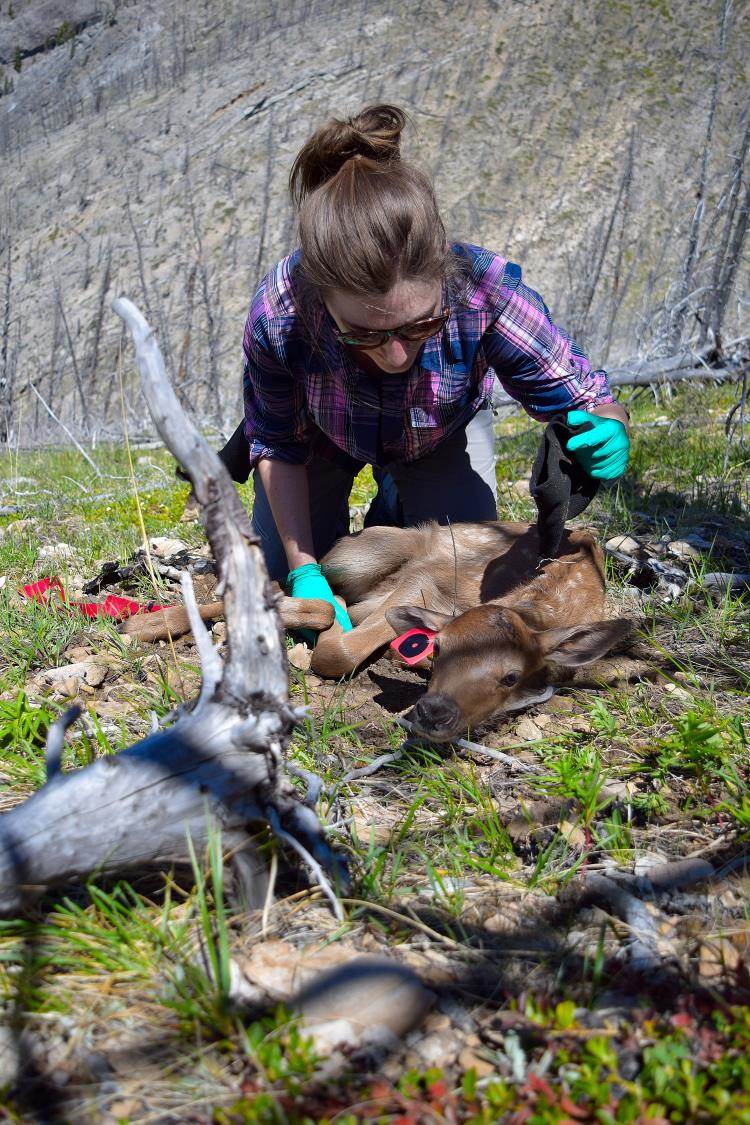My research is looking at the relationship of carnivores and ungulates in the Upper Red Deer River watershed, which includes Ya Ha Tinda (YHT) and Banff National Park. YHT is home to the winter range of a partially migratory herd of elk that has been declining the last several decades with the recovery of wolves in Banff National Park. Along with this decline, there are shifts in the migratory behaviour of the elk since the early 2000s where a larger proportion of elk are not migrating during the summer, staying year-round on the Ya Ha Tinda ranch. Additionally, there is evidence of a new migratory path onto eastern industrial lands, and these elk are exhibiting higher calf-cow ratios relative to their western and resident counterparts. The focus of the 15-year long YHT elk monitoring project is the role of predation in the changing elk dynamics.
Predation risk has previously been modeled using surrogates for risk such as distribution of predators or encounters between predator and prey. Although commonly used, these metrics may not reflect attack success by a predator. The goal of this project is to provide a spatial model of mortality risk for ungulate prey by measuring where predator scats are found and what prey are present in these scats. The objectives of my research are to: (1) compare the contents of summer scats of cougars, grizzly bears, black bears, wolves and coyotes across landscapes with emphasis on distinguishing contents of elk adults and calves; (2) relate contents of elk calf and elk adult in predator-specific scats to the distribution of other predators and environmental characteristics of areas around scat locations; and (3) spatially model the mortality risk to elk based on scat contents across the Ya Ha Tinda region and assess model predictions to known ungulate kill sites. This study will be an important next step for improving the assessment of spatial risk to different migratory segments of this elk population, and addresses the question in a novel way.
Awards:
Department of Biological Sciences Graduate Teaching Award – April 2018
Bill Samuel Graduate Student Service Award (2017)
Graduate student presentation award – Alberta Chapter of the Wildlife Society (2017)
Alberta Graduate Scholarship (2017)
Queen Elizabeth II Graduate Scholarship (Sept 2016 – April 2017)
Technical Reports:
Spilker, E. K. MacAulay, and E. Merrill. Spatial interactions of predators in a multi-carnivore community: implications for ungulate predation risk in the Rocky Mountains of Alberta. Wild Sheep Foundation of Alberta Newsletter, January 2016.
Publications:
Normandeau, J., MacAulay, K., Berg, J. and Merrill E. 2018. Identifying guard hairs of Rocky Mountain carnivores. Wildlife Society Bulletin (In Press).
Popular Articles:
MacAulay, K, Normandeau, J and Boyce, M.S. 2017. The Hairy Truth: Investigating predator-prey interactions. Alberta Outdoorsman. January: 16-18.
Presentations:
MacAulay, K., E. Spilker, J. Berg and E. Merrill. 2018. Spatial mortality risk for elk in a multi-predator community. Presentation. International Deer Biology Congress, Estes Park, Colorado.
MacAulay, K., E. Spilker, J. Berg and E. Merrill. 2018. Spatial mortality risk for elk in a multi-predator community. Presentation. Alberta Chapter of the Wildlife Society Conference, Lethbridge, AB.
MacAulay, K., E. Spilker, J. Berg and E. Merrill. 2018.Spatial mortality risk for elk in a multi-predator community.Presentation. R.E. Peter Biology Conference, University of Alberta, Edmonton, AB.
MacAulay, K., E. Spilker, J. Berg and E. Merrill. 2017. Guess who’s coming to dinner? Linking predator diets to elk predation risk. Presentation. A Celebration of Alberta Conservation Association Research Funding Reception, Edmonton, AB.
MacAulay, K., Spilker E., Steenweg, R. Merrill, E. 2017. Guess who’s coming to dinner? The role of elk in cougar and wolf diets. Presentation. Alberta Chapter of the Wildlife Society Conference, Lac la Biche AB.
Spilker, E., MacAulay, K., Merrill, E., Steenweg, R., Hebblewhite, M. and Whittington, J. 2017. Assessing relative abundance and resource selection functions for predicting predation risk in a multi-species predator community. Presentation. Alberta Chapter of the Wildlife Society Conference, Lac la Biche AB.
MacAulay, K., Spilker, E., Steenweg, R., and Merrill, E. 2017. Do spatial differences in carnivore diet reflect predation risk for elk? Poster Presentation. Canadian Parks Conference, Banff AB.
MacAulay, K., Spilker, E., Steenweg, R., and Merrill, E. 2017. Do spatial differences in carnivore diet reflect predation risk for elk? Poster Presentation. R.E. Peter Biology Conference, University of Alberta, Edmonton, AB.
Spilker, E., MacAulay, K., Merrill, E., Steenweg, R., Hebblewhite, M. and Whittington, J. 2017 Assessing relative abundance and resource selection functions for predicting predation risk in a multi-species predator community. Poster Presentation. R.E. Peter Biology Conference, University of Alberta, Edmonton, AB.
 MacAulay, K., E. Spilker, R. Steenweg, J. Whittington, and E. Merrill. 2016. Do spatial differences in diet reflect predation risk for elk? A proposal. Presentation. R.E. Peter Biology Conference, University of Alberta, Edmonton, AB.
MacAulay, K., E. Spilker, R. Steenweg, J. Whittington, and E. Merrill. 2016. Do spatial differences in diet reflect predation risk for elk? A proposal. Presentation. R.E. Peter Biology Conference, University of Alberta, Edmonton, AB.
Spilker, E., K. MacAulay, E. Merrill, R. Steenweg, M. Hebblewhite and J. Whittington. 2016. Assessing relative abundance and resource selection functions for predicting predation risk in a multi-species predator community. Presentation. Columbia Mountains Institute of Applied Ecology, Revelstoke, B.C.
Funding Agencies:
Alberta Conservation Association
Colleges and Institutes Canada CleanTech Internship
Safari Club International – Northern Alberta Chapter
TD – Friends of the Environment Foundation
Wild Sheep Foundation of Alberta
Contact Info:
kmacaula@ualberta.ca
